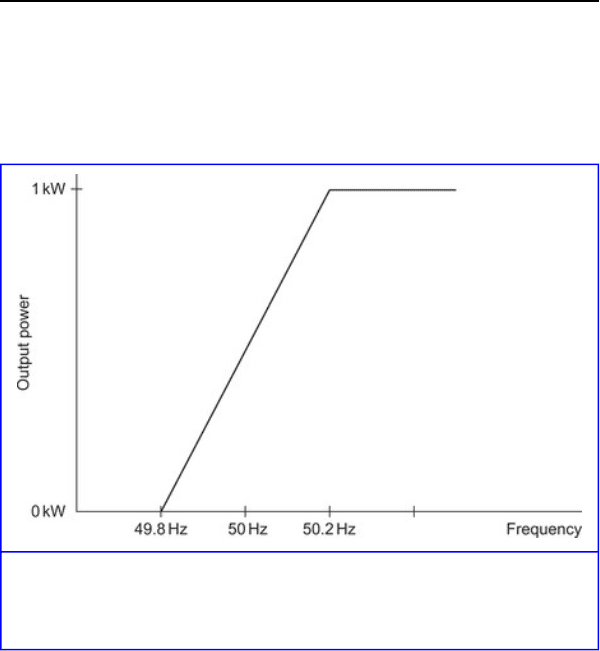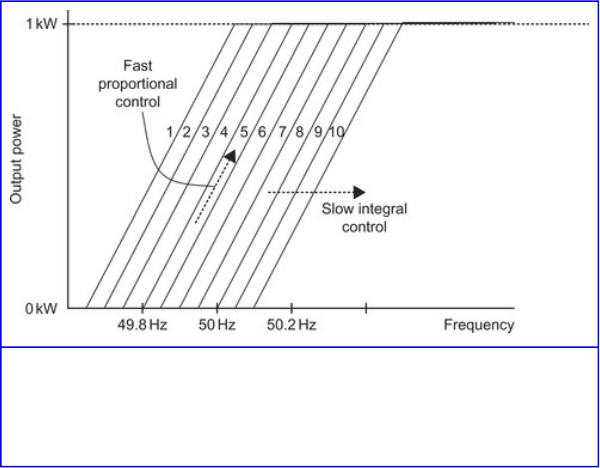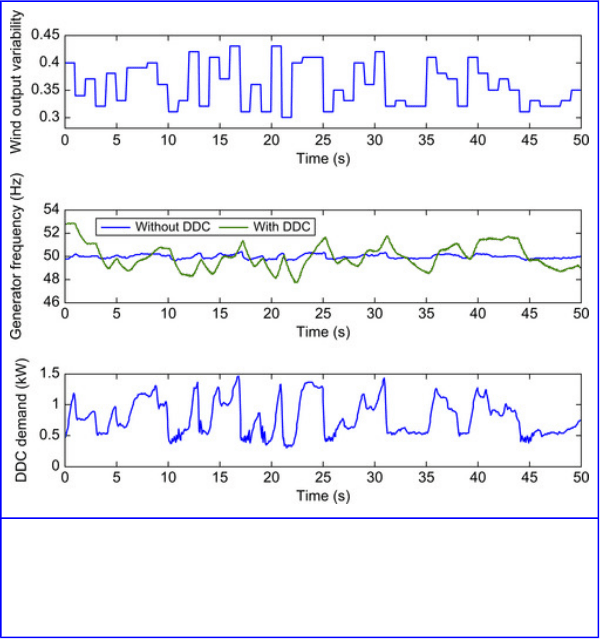Sioshansi F.P. Smart Grid: Integrating Renewable, Distributed & Efficient Energy
Подождите немного. Документ загружается.


2010, which is a typical day. Over this time, the frequency in
each island moved over +/– 0.1 Hz.
Figure 18.9
Variation in power system frequency in the New Zealand power system.
Source: Internal Transpower information
Variations of this magnitude and speed would be rare in a
large power system such as Europe but are common in
smaller systems. In New Zealand most excursions are within
the normal band, which is 49.8 to 50.2 Hz, and frequency
typically returns to within the normal band within 2 minutes.
Momentary frequency excursions of up to 51.5 Hz and down
to 48 Hz are quite common. These excursions can be caused
by the loss of a large load such as a reduction line at the Tiwai
Point Aluminium Smelter or the loss of a large generating
unit. The loss of a reduction line, around 180 MW, is large
891
compared to the load on the South Island power system,
which ranges between 1,100 and 2,200 MW. The largest
generating units in the North Island are around 400 MW in
size, which compares to North Island load that ranges
between 1,600 and 4,600 MW.
The System Operator in New Zealand manages the frequency
fluctuations described above through the procurement of three
ancillary services [11]
20
:
20
The specification of ancillary services varies from power system to
power system.
• Instantaneous reserves: Fast acting reserves from partially
loaded generating plant, certain hydro generating units
operating in tail water depressed mode and interruptible
load are procured to arrest the decline in frequency for the
loss of large generating units or an HVDC pole. The cost of
instantaneous reserves currently varies between NZ$66 and
NZ$72 million per year.
• Frequency keeping: A generating station referred to as the
frequency keeping station is dispatched in each island to
manage frequency. These stations will adjust output to
maintain frequency to within the target normal band, which
is 49.8 Hz to 50.2 Hz. The cost of frequency keeping
currently ranges between NZ$50 and NZ$100 million per
year.
• Over-frequency reserves: Certain generating units are
provided with over-frequency protection systems that
operate in a coordinated manner when there is a sudden
increase in frequency due to the loss of a large load. The
cost of over-frequency reserves is currently around NZ$0.7
million per year.
892

Using DDC for Frequency Control
DDC can help stabilize the network at the target frequency by
adding or removing load in response to real-time
measurements of the system frequency. The concept is
illustrated in Figure 18.10.
Figure 18.10
Response characteristics for a 1-kW DDC-controlled load.
As seen, when the system frequency varies over a control
range—49.8 Hz to 50.2 Hz in this example
21
—the consumer
load varies from zero to its maximum value of 1 kW. If the
system frequency is 49.8 Hz or lower, then there will be no
demand from the DDC-controlled load on the power system,
whereas if the system frequency is greater than 50.2 Hz then
the full 1-kW load will be added to the system.
893
21
Both the range of control (0.4 Hz here) and the center frequency (50 Hz)
can be varied as required for the particular application.
The consumer may independently turn this load off with a
switch, but it may not turn on immediately when wanted—as
it depends on the system frequency. As the main use of the
response is during system events, such as outages of power
plants or major transmission lines, delays experienced when
turning on a load are infrequent and only for short durations
until generation has been adjusted.
Load types that work well with DDC, apart from recharging
of EVs, could be washing machines, water heaters, pool
pumps, and refrigerators (i.e., types of demand where the
service is not affected by power being switched off for shorter
periods of time). In practice, a system as big as the one in
New Zealand could have several million DCC controllers,
which would contribute to providing reliability.
DDC can either be built into the EV car chargers and
household appliances themselves or into a “smart box” at the
metering point that controls different appliances through a
home area network, office network, and so on. The signal is
available to anything connected to the power system. As such,
there is no need for two-way communication for DDC to
work effectively, but there would still be benefits of two-way
communication as discussed in Section “Towards a Smarter
DDC.”
894

DDC Development Trends
Early Days
The concept behind DDC is far from new. It was developed
by Fred Schweppe, an American engineer, in the late 1970s
[12]. However it has evolved little subsequently, partly due to
difficulties within the regulatory framework in rewarding
DDC systems. It did see significant development during the
1980s in New Zealand, where islanded system made it
particularly interesting (e.g., [13], [14], [15] and [16]). Based
on that work, DDC technology has been manufactured and
sold commercially to hundreds of small-scale applications
around the world in sizes ranging from less than 1 kW to
greater than 200 kW.
More recently, there has been an increasing interest,
exemplified by the Grid Friendly appliances work by Pacific
Northwest National Laboratory in the US [17],
demonstration-scale trials by RLtec in the UK [18] and a
study about how DDC can be used to stabilize frequency on
the Danish island of Bornholm [19].
Towards a Smarter DDC
The simpler system explained so far can be enhanced in a
system with two-way communication. With two-way
communication available, the System Operator would have
the ability to continually alter the response curves of
individual loads to end up with a system that can restore
system frequency to 50 Hz after a major outage, regardless of
the actual uncontrolled load.
895

Such a system is shown in Figure 18.11 where 10 loads
(numbered 1–10) are shown with different response curves.
This ensures fast proportional control that stabilizes the
system and slow integral control that ensures the frequency is
restored to the desired frequency, here 50 Hz, over time.
Figure 18.11
Example of response curves for a set of DDC controllers (here 10) to restore
system frequency at 50 Hz.
Response curves can also be altered to take into account
distribution network constraints—such as real-time
monitoring of transformer temperatures—only allowing
responses that do not cause any risk of overloading assets.
Another benefit of having data access through two-way
communication comes from enabling the System Operator to
monitor the overall supply-demand balance. Even if the
system frequency is 50 Hz, the system risk is very different
896
depending on whether all DDC-capable demand is utilized or
only a minor part.
Lastly, knowing who has contributed to restoring frequency
allows for better rewarding. Without this information, all
DDC customers would get the same overall discount. There
will be more system benefits arising from those who plug in
the EVs at any time they are not using it compared to those
who only plug it in when the battery level is below 20% and
they want it recharged.
Smart—Without the Smart Grid
Price-based optimization of demand for EVs as described in
the section “The Opportunity at Hand” will assure optimal
economic allocation of resources where the marginal
willingness to pay matches the marginal cost of production. It
does, however, rely on smart grid infrastructure in the form of
smart meters connected with two-way communication that
send the price signal to the consumers and subsequently settle
accounts according to the response.
Smart grids are expensive to build, and for many developing
countries, they will not exist for years. Even among the larger
developed countries, there might be rural areas that are
considered too expensive for a smart grid rollout. A DDC can
achieve some of the outcomes seen in the section “The
Opportunity at Hand” but without the smart grid
infrastructure.
A laboratory-scale experiment has been undertaken at
Auckland University showing that two different “energy
flows” can coexist in the same network. Here a wind
generator subject to a gusting wind flow was simulated. This
is shown in the upper chart of Figure 18.12.
897

Figure 18.12
Experimental results with a DDC system. Upper trace: Generation change,
Middle: System frequency, Lower: DDC demand.
The system had a DDC controller, which acted as if charging
an EV battery. The use of this is shown in the lower chart of
Figure 18.12, while the frequency either with or without this
DDC controller is shown in the middle graph.
It can be seen that the system is capable of keeping frequency
to a narrower band while the same amount of energy is
recharged over the time period. Thus it is feasible to transmit
fluctuating power through a grid and capture it by types of
load, which can be shifted, elsewhere in the system. A
898

grid-scale experiment on this technique is needed to show
whether it is scalable.
While the experiment looked at intermittency in the shorter
term (seconds), it will work for longer time horizons as well,
say 24 hours. The new paradigm is that connected DDC
devices are not guaranteed power at any particular time, but
over a 24-hour period they will get some fractional energy
guarantee. Some types of intermittent generation will be able
to give a rather high energy guarantee (e.g., solar and tidal),
while for wind it will be lower.
Economics of DDC
The single most important driver for these developments with
DDC, and other grid management systems, is reducing the
operating cost of the grid. Some of the possibilities are
outlined in this section with a view to seeing how it might be
possible to make system improvements using DDC.
At present frequency keeping involves using essentially one
power station operating at partial load so that it can pick up
load when required or reduce power when needed. For a
generator operating at less than full output, this means a
considerable opportunity cost. Also for most generation
technologies, especially thermal generation, running at
reduced output means running at reduced fuel efficiency and
higher emissions.
These costs range from NZ$50 to NZ$100 million per year in
the New Zealand system alone. Using DDC the power
stations could run at full power, and excess generation would
be used in water heating and other ‘energy’ loads. Thus this
899
simple DDC controller allows matching the generation to the
load and controlling the frequency to be 50 Hz. When the
load changes the frequency transiently changes from 50 Hz,
but as the frequency is restored by choosing the appropriate
response the load is also matched to the generation.
In New Zealand, the System Operator annually spends
between NZ$66 and NZ$72 million to procure instantaneous
reserves to cover the loss of a large generating unit or the loss
of an HVDC pole.
22
Some of that is provided by industrial
and distribution load reductions, but the majority is from
generators. As for frequency keeping, generators providing
instantaneous reserve will have an opportunity cost for not
generating as well as an extra fuel cost—or higher water use
per MWh generated for hydro power plants—for not
operating at their most efficient point.
22
The loss of both poles (bipole outage) is not covered by the reserves
provision. Covering the loss of a bipole would require up to 1,200 MW
of capacity from 2013 while ~400 MW normally is enough for a single
pole failure or loss of the largest generating unit. To prevent the whole
country from blackout in case of a bipole outage, an AUFLS (automatic
under-frequency load shedding) system is in place. In such a case, up to
33% of the demand will be shed on the importing island, not gradually as
in DDR, nor by appliance level, but with whole distribution feeders
being cut completely to save the remaining system from a total blackout.
Using DDC would allow most of the NZ$66 to $72 million
per year to be saved. These are costs that could be paid to
equipment providers to build in a chip that makes water
heaters, refrigerators, electric car chargers, etc. DDC capable.
A calculation of the amount of MW that could be obtained
from domestic refrigeration in New Zealand shows that about
140 MW of controllable capacity can be obtained longer term
900
